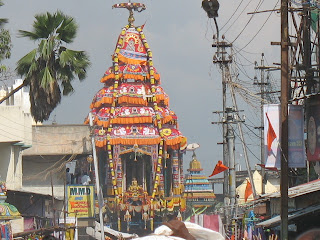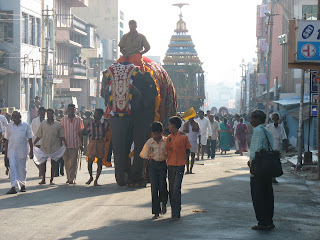Click to enlarge all photographs
"There are several Big Cars, huge wooden carts carved with fabulous mythological figures telling all the stories, with the biggest wheels in the world; the biggest car dwarfs all the buildings in town except the giant temple towers. It is called The Big Car.
The splendid bronze figures of Annamalai and Unnamalai - male and female personifications of Arunachala, are heavily garlanded and bejeweled, seated up on The Biggest Car; the towering edifice is covered with long strips of embroidered cloth and gigantic flower garlands. There are several big cars pulled before and after The Big Car; there’s a women-only one carrying Abhithakuchalambal, and there’s also a kids’ car, which trails flamboyantly at the end.


Years ago we used to walk in to watch the Big Car come up the incline of one main street around midday; for years and years and years, we’d all have lunch in ashram and then everyone would make their way around to the east face of the hill to meet the gods coming up Thiruvoodal street. But now there are so many pilgrims that the schedule has extended interminably. Inauspicious times of the day intervene so the proceedings stop until the bad hour has passed, and there’s also the time when suddenly everyone goes home for lunch.



Upon the up-roaring signal of its visibility from the crowd, Hari dropped his pile of coat-hangers and rushed to be held up over the balcony. His eyes popped, his ears flapped. Even though we’d seen it before, nothing can prepare us for the majesty of its annual sight. Below us the street was a sea of heads; all balconies and rooftops up and down the street full of faces and now that the Big Car appeared, bodies behind us pressed forward, pushing us onto the balcony rails festooned with dubious electrical fairy lights. It’s quite exciting.

Since the divinities are coming, dedicated persons don’t wear shoes. This year we noticed one Policewoman wearing socks to protect her dainty feet from the yucky street. About five thousand pilgrims pull the cart around the temple circuit-route, ladies on one side and gents on t’other. When the car stops, big chocks of heavy wood are wedged underneath the enormous wheels while the pullers take a rest and offerings are made to their majesties the gods. When ready to start again, young men with enthusiasm climb up onto the chocks with poles to steady themselves, and on signal they jump up and down on the slanted chocks until their force pushes the wheels forward, giving momentum for the pullers to haul the cart further up the street.

Looking down into the crowd below as the cart passed beneath us, we were treated to a seething mass of human energy - drums beating in time to muscles, bystanders shouting encouragement, enormous wheels slowly turning, the carving on the cart creaking, embroidery panels blowing in the wind, garlands wavering about, lucky little boys sitting up high lowering cloth carry bags on strings for people to send up coconuts and flowers, the Brahmin priests looking down impassively.

It’s the Brahmins particularly – the extravagant courtly costumes, the imperious faces staring down – that convey the true sense of the gods as majesties: as the most important personages in our world, out on a tour of the town, to be saluted by their adoring subjects. And a very large number of their adoring subjects are sweating, straining at the edge in the effort required to pull them. The Big Car teeters its way uphill until the momentum runs out. The chocks are wedged in again. Everyone breathes.

It will take about ten hours to circumnavigate the temple.”





























